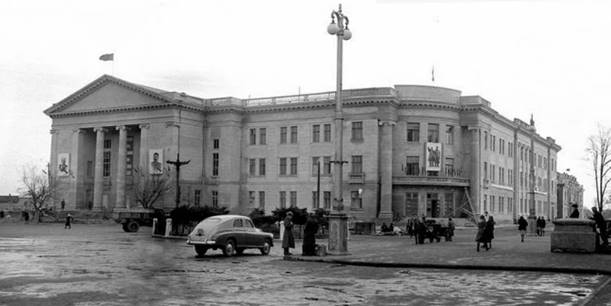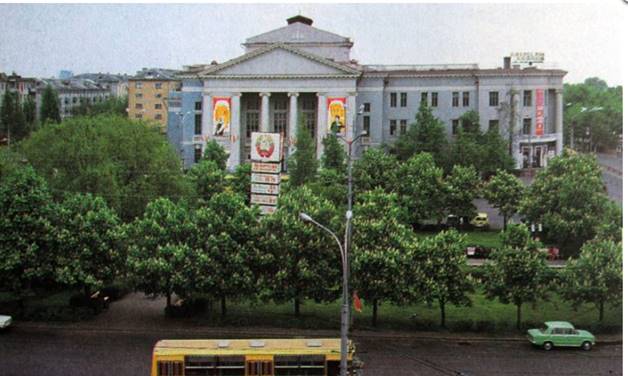Privokzalnaya square, 4
Palace of Culture of Railway
Workers Gomel, Privokzalnaya square, 4
The building of the Palace of Culture of Railwaymen is one of the architectural dominants of the Station Square, forms its southern side and consists of three volumes clearly distinguished by their functional purpose: a theater and concert hall with utility rooms, a club part and a sports hall, which are interconnected and form an inner courtyard.
The exteriors of the palace are solemn and majestic. The main facades are divided into two tiers – the lower (1st floor, rectangular rustication) and the upper (2-3 floors, piers with rustication of the same type). Columns and pilasters of the Ionic order are widely used in the decor. All windows are rectangular, on the ground floor they are decorated with a keystone, under the windows of the third floor there are window sills. A cornice with dentils passes along the perimeter of the building.
The entrance to the corner semicircular volume of the club part at the corner of the square and Kiseleva st. is flanked by columns. On the second floor of the volume there is a loggia-terrace with a balustrade. This part of the facade is crowned by a stepped attic. The facade from Kiseleva Street is decorated with three narrow risalites (the central one is highlighted by pilasters), completed with rectangular attics. At the level of the second floor, the club part is connected through a covered passage with a 2-storey volume of a sports hall with a stepped attic.
The composition on the side of the square is dominated by the block of the theater and concert hall, which protrudes beyond the red line of the facade and includes the main entrance - a classic portico with columns and pilasters, completed with a triangular pediment with a cornice with denicles. On the upper tier, balustrade window sills complement the windows with ribbon glazing. The facade is completed with a balustrade parapet. On the side of Privokzalnaya Street, the facade is dominated by a wide risalit, the entrance group of which in the center is decorated with alternating pilasters with elongated windows, and it is crowned by an attic floor with a balustrade parapet.
The interiors decorated with marble, stucco, parquet are also of artistic value. As in the exterior, mainly elements of the classical style are used.
The V.I. Lenin Palace of Culture and Technology of Railway Workers has undergone several reconstructions during its existence. The author of the original project was architect A. Kirillov. The building was erected in 1926 – 1930 . The exterior was decided in the then dominant style of constructivism. During the Great Patriotic War, as a result of heavy bombing, it was partially destroyed.
The reconstruction plan of the palace after the war was carried out by the Kiev design office of the Soyuztransproekt association (author – architect I. Pestrakov). The exterior was radically changed, partly the internal layout. The neoclassical style began to dominate in the design of the building, in which the entire Station Square and Komsomolskaya St. (now Lenin Ave.) were built. Constructivism in the exterior retained only the volume of the cinema (now a sports hall). The work was completed in 1950 .
For a long time, the famous Belarusian choreographer, honorary citizen of the city of Gomel, People's Artist of the BSSR Alexander Alekseevich Rybalchenko (1911 – 2002) worked at the Palace of Culture. He studied at the theater studio at the Gomel Tram (1931 – 1935) under the guidance of K. Aleksyutovich and E. Mirovich. Participant of the Great Patriotic War, awarded the Order of the Red Star and the medal «For Military Merit». From 1936 to 1941 and in 1945 – 1958 A. A. Rybalchenko led the dance group of the railway workers club. In 1958 – 1982 . – Choreographer and artistic director of the Gomel Folk Song and Dance Ensemble. At the same time, in 1945 – 1982 – Artistic director of the Gomel Palace of Culture and Technology of Railway Workers named after V. I. Lenin. In 1959, A.A. Rybalchenko was awarded the title of «People's Artist of the BSSR» to the first of the leaders of amateur art collectives of the BSSR. In 1960, the song and dance ensemble of the Palace of Culture of Railway Workers was the first in the republic to receive the title of «People's Amateur Collective». The master widely used and developed the wealth of folk choreography.
In 1998, the next planned reconstruction of the building began.
In 2000, the cultural complex of RUE «Gomel Branch of the Belarusian Railway» was created on the basis of the Palace of Culture of Railway Workers. A sports complex was created in the volume of the former cinema, the areas of the theater and concert hall were expanded. On May 6, 2011, the palace opened its doors after reconstruction. Among club associations, studios, amateur groups, etc. the People's Choir of War and Labor Veterans, the People's Studio of Modern Ballet «Tandem», the People's Vocal Ensemble «Gomelchanka», the People's Theater of Musical Associations «Atman», the People's Studio of Pop Song «Sonore», the exemplary dance Ensemble «Friendship».
In 2023, the building was transferred to the Gomel Regional Philharmonic.
 Rybalchenko Alexander (1911-2002) – Belarusian Soviet choreographer, People's Artist of the BSSR (1959), Honorary Citizen of Gomel (1988). Participant of the Patriotic War.
Rybalchenko Alexander (1911-2002) – Belarusian Soviet choreographer, People's Artist of the BSSR (1959), Honorary Citizen of Gomel (1988). Participant of the Patriotic War.
 Privokzalnaya square. V.I. Lenin Palace of Culture and Technology of Railway Workers. Photo of 1934
Privokzalnaya square. V.I. Lenin Palace of Culture and Technology of Railway Workers. Photo of 1934
 Privokzalnaya square. V.I. Lenin Palace of Culture and Technology of Railway Workers. Photography of the 1930s.
Privokzalnaya square. V.I. Lenin Palace of Culture and Technology of Railway Workers. Photography of the 1930s.
 Privokzalnaya square. V.I. Lenin Palace of Culture and Technology of Railway Workers. Photography of the 1950s.
Privokzalnaya square. V.I. Lenin Palace of Culture and Technology of Railway Workers. Photography of the 1950s.
 Privokzalnaya square. V.I. Lenin Palace of Culture and Technology of Railway Workers. Photo of 1985.
Privokzalnaya square. V.I. Lenin Palace of Culture and Technology of Railway Workers. Photo of 1985.
 Station square. Cultural and sports complex of RUE «Gomel branch of the Belarusian railway».
Station square. Cultural and sports complex of RUE «Gomel branch of the Belarusian railway».